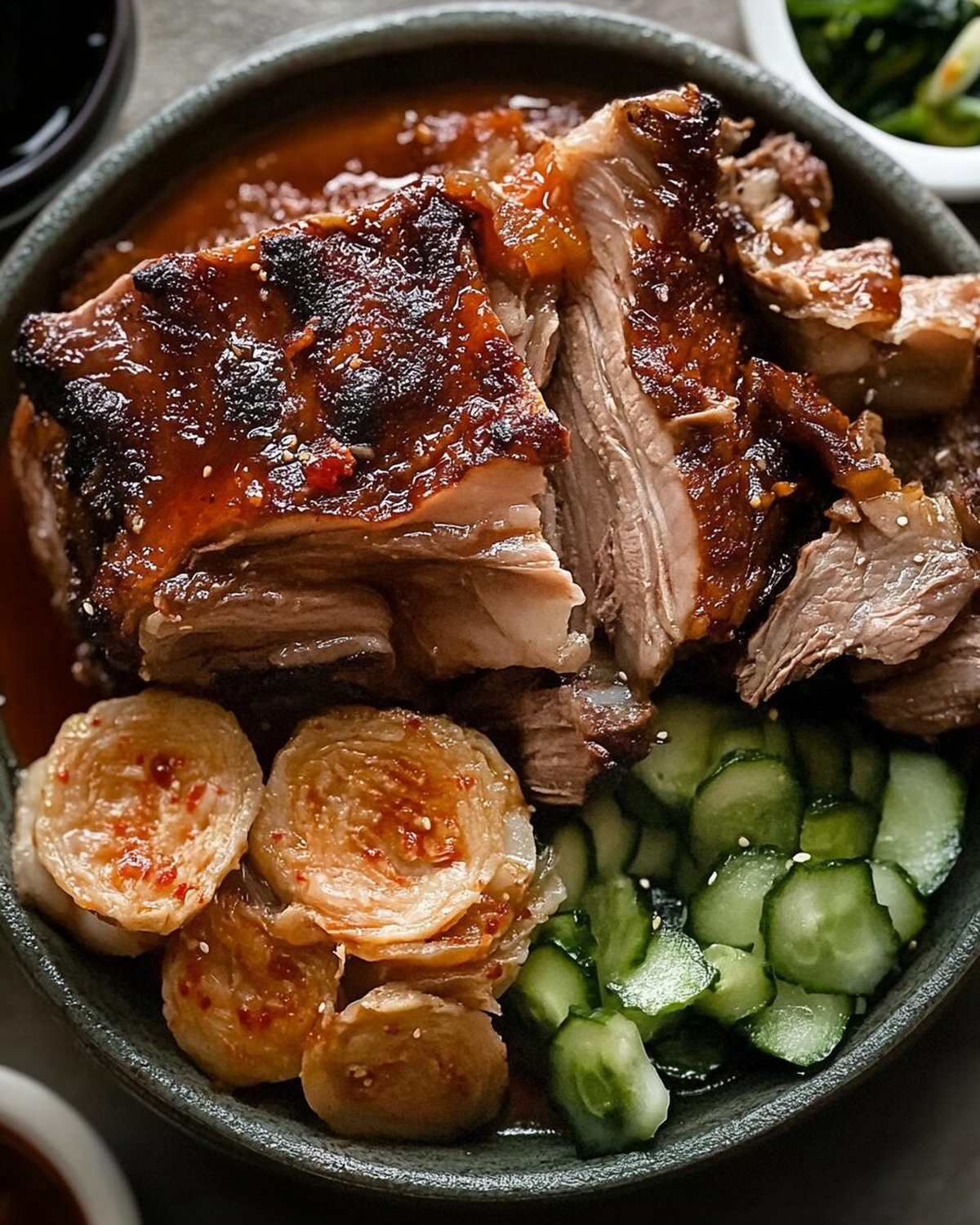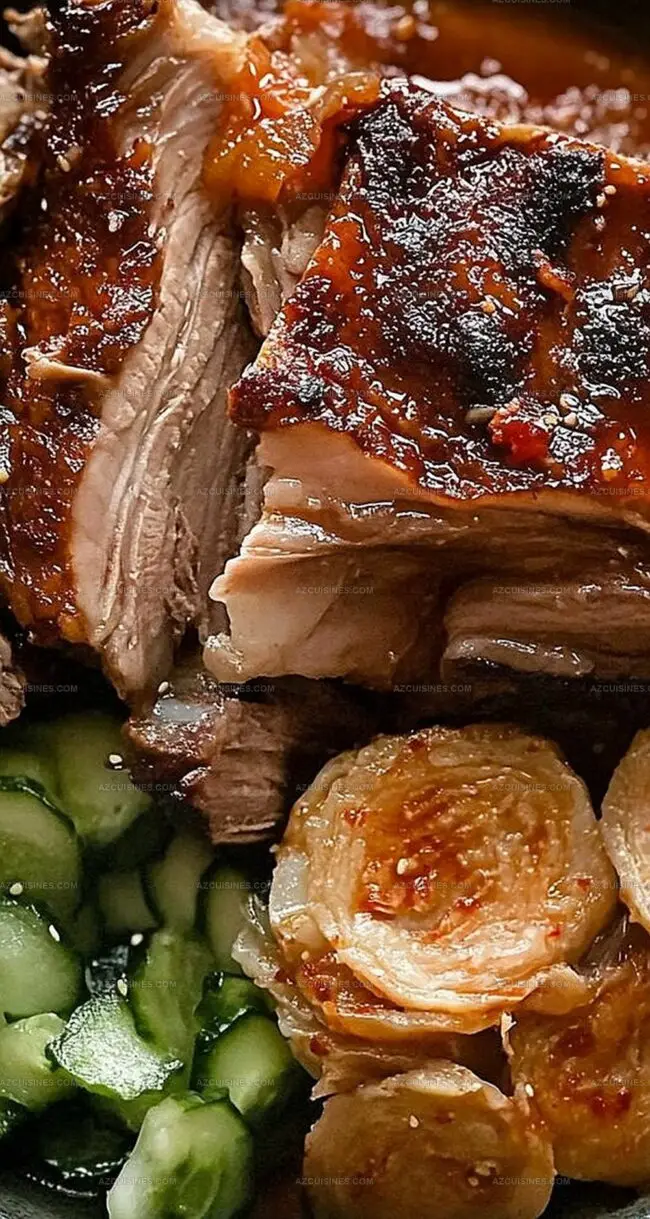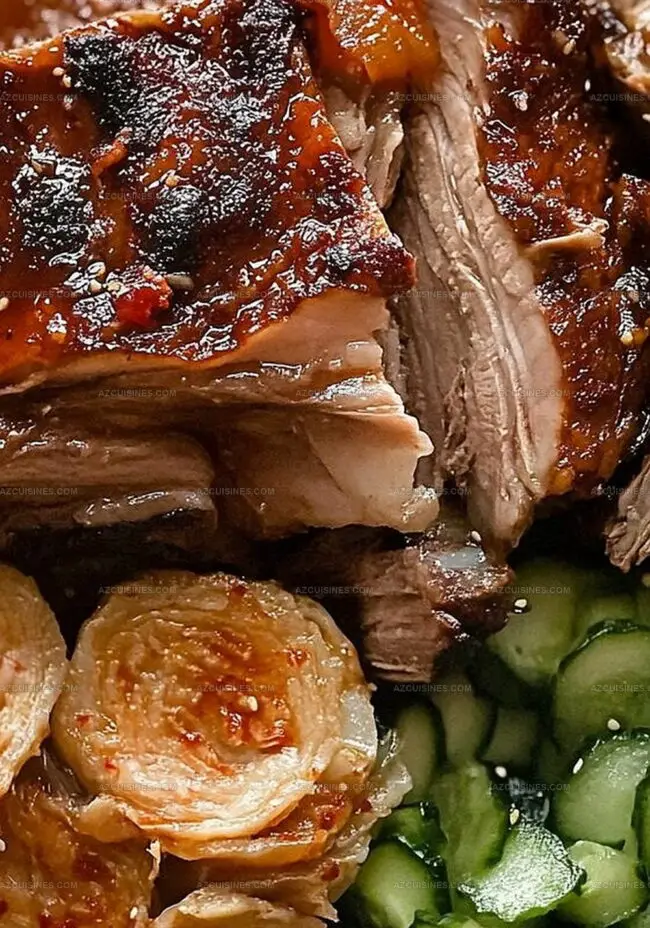The Epic Momofuku Bossam Recipe: Korean Pork Magic At Home
Crafting a delectable momofuku bossam reveals a culinary adventure that blends korean traditions with modern flair.
Tender pork shoulder becomes the star of this mouthwatering dish.
Slow-cooked meat melts effortlessly, promising an explosion of rich flavors.
Salt, sugar, and carefully selected spices create a magical marinade that seeps deep into every fiber.
Lettuce wraps add a fresh, crisp element to complement the succulent protein.
Crispy edges and juicy interior make this recipe a true crowd-pleaser.
You’ll want to savor each bite and share this spectacular korean-inspired feast with everyone around your table.
Why Momofuku Bossam Is Unforgettable
Ingredients for Flavorful Momofuku Bossam
Main Protein:Dry Cure Ingredients:Roasting Ingredients:Sauce Ingredients:Serving Accompaniments:Crafting Momofuku Bossam at Home
Step 1: Prepare the Pork Cure
Blend white sugar and kosher salt in a mixing bowl. Thoroughly pat the pork dry with paper towels, then massage the salt-sugar mixture all over the meat, making sure to cover every surface.
Place the seasoned pork in the refrigerator, covered, and let it cure for a full day to a day and a half.
Step 2: Slow Roast the Tender Meat
Heat the oven to a gentle 300°F.
Position the pork in a roasting pan and cook uncovered for five hours. Every hour, carefully spoon the delicious pan juices over the meat to keep it moist.
After cooking, let the pork rest for 10 minutes to allow the juices to redistribute.
Step 3: Create a Caramelized Crust
Crank up the oven temperature to a blazing 500°F.
Generously coat the pork with:Roast for 10 minutes until a gorgeous, sticky caramelized crust forms on the exterior.
Step 4: Whip Up Ginger Shallot Sauce
Combine the following ingredients in a bowl:Let the sauce sit and meld flavors for 20 minutes before serving.
Step 5: Mix Spicy Ssam Sauce
Blend together:Stir until completely combined.
Step 6: Assemble and Devour
Arrange the cooked pork on a platter surrounded by:Invite guests to create their own wraps by placing pork, rice, and condiments inside a lettuce leaf.
Add ginger sauce and spicy ssam sauce for an explosion of flavors. Roll up, take a bite, and enjoy the mouthwatering Korean-inspired feast!
Smart Tips for Better Bossam
Flavor Ideas for Momofuku Bossam
What to Eat with Momofuku Bossam
Keeping Leftover Bossam Just Right
Momofuku Bossam Frequently Asked Questions
The dry curing process is crucial. By mixing white sugar and kosher salt and coating the pork thoroughly, you’re drawing out moisture and infusing flavor deep into the meat before slow cooking.
Slow cooking at a low temperature of 300°F for 5 hours ensures the pork becomes incredibly tender and breaks down connective tissues, resulting in melt-in-your-mouth meat that’s packed with rich flavor.
The high-temperature roasting with brown sugar creates a caramelized exterior that adds a delightful crispy texture and sweet-savory crust, giving the pork an amazing depth of flavor and beautiful golden-brown appearance.
Print
Momofuku Bossam Recipe
- Total Time: 29-41 hours 10 minutes
- Yield: 8 1x
Description
Korean-style pulled pork Momofuku Bossam elevates family dinners with its rich, tender meat and complex flavors. Succulent pork shoulder slow-cooked in aromatic spices creates a feast you’ll savor with lettuce wraps and zesty ssamjang sauce.
Ingredients
Meat:
- 3.5–4 kg/7-8 lb pork butt/shoulder, bone-in, skinless
Side Ingredients:
- 4–5 heads butter/bib lettuce (40–50 leaves)
- 3 cups cooked white rice
- 500g/1 lb kimchi
- 12+ oysters, raw, in shell (optional)
Seasoning and Condiments:
- 1/2 cup (110g) white sugar
- 1/2 cup (115g) kosher or cooking salt
- 7 tablespoons brown sugar, light or normal
- 1 tablespoon kosher or cooking salt
- 2.5 cups scallions, thinly sliced (both green and white parts)
- 1/2 cup fresh ginger, peeled and finely grated
- 1/3 cup canola oil
- 1.5 teaspoons light soy sauce
- 1 teaspoon sherry vinegar
- 1/2 teaspoon kosher or cooking salt
- 2 tablespoons ssamjang
- 1 tablespoon gochujang
- 5 teaspoons sherry vinegar
- 2 tablespoons canola oil
- 1 tablespoon water
- 1 teaspoon white sugar
Instructions
- Initiate the dry-curing process by thoroughly massaging a blend of white sugar and kosher salt into the pork’s surface, ensuring complete coverage. Refrigerate the seasoned meat, fully covered, for 24-36 hours to enhance flavor penetration.
- Position the oven rack to 300°F (150°C). Roast the pork uncovered for 5 hours, periodically basting with its own rendered juices to maintain moisture and develop deep, rich flavors. Allow the meat to rest for 10 minutes after initial roasting.
- Elevate the oven temperature to 500°F (260°C). Generously coat the pork with a mixture of brown sugar and salt, creating a caramelized exterior through high-heat roasting for approximately 10 minutes until a glossy, crisp crust forms.
- Craft the ginger shallot sauce by combining finely chopped scallions, minced ginger, canola oil, soy sauce, sherry vinegar, and a pinch of salt. Let the mixture meld and develop flavors for 20 minutes before serving.
- Prepare the spicy ssam sauce by whisking together ssamjang, gochujang, sherry vinegar, canola oil, water, and sugar until a smooth, vibrant condiment emerges.
- Assemble the feast by presenting the roasted pork alongside fresh lettuce leaves, steamed rice, tangy kimchi, briny oysters, and the prepared sauces. Diners can create personalized wraps by layering pork, rice, and condiments within crisp lettuce leaves.
Notes
- Ensure the pork is thoroughly dried before applying the salt and sugar cure to maximize flavor absorption and create a crispy exterior.
- Rest the pork in the refrigerator for the full 24-36 hours to allow the cure to penetrate deeply and tenderize the meat.
- Use a meat thermometer to check internal temperature, aiming for around 195°F for fall-apart tender texture that’s perfect for pulling.
- For a gluten-free version, substitute soy sauce with tamari and ensure all other ingredients are certified gluten-free.
- Prep Time: 24-36 hours
- Cook Time: 5 hours 10 minutes
- Category: Dinner, Appetizer, Snacks
- Method: Roasting
- Cuisine: Korean
Nutrition
- Serving Size: 8
- Calories: 525
- Sugar: 12 g
- Sodium: 1100 mg
- Fat: 28 g
- Saturated Fat: 4 g
- Unsaturated Fat: 22 g
- Trans Fat: 0 g
- Carbohydrates: 40 g
- Fiber: 1 g
- Protein: 24 g
- Cholesterol: 90 mg




Truc Tran (Kris)
Senior Food Editor
Expertise
Home Cooking, Meal Planning, Recipe Development, Baking and Pastry, Food Editor, Cooking-video Maker, Vietnamese Food Evaluation Expert
Education
Truc Tran (Kris), an experienced food writer and editor, is great at exploring and describing global cuisines, from simple street food to fancy dining. In her writing, she skillfully mixes different flavors, cooking methods, and culinary traditions, showing the unique character of various cultures through their food and drinks. On azcuisines.com, Kris highlights her knowledge, especially in Asian cuisine and worldwide traditional dishes.